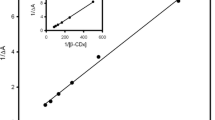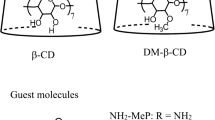Abstract
The interaction between 6-aminobenzothiazole (6ABT) and β-cyclodextrin (β-CDx) has been investigated in solution and solid state. The stoichiometry and binding constants of the complex between 6ABT and β-CDx in solution have been determined by steady state and time-resolved fluorescence spectroscopy. Fluorescence intensity of neutral form decreases during complexation which is contrary to the usual observation. This is explained by hydrogen bonding interaction between lone pair of nitrogen with OH groups of β-CDx. The FT-IR spectral study and SEM images of solid complex confirmed the formation of inclusion complex. Excited state acidity constants for 6ABT have been determined in aqueous and β-CDx medium and discussed.












Similar content being viewed by others
References
Szejtli J (1982) Cyclodextrin and their inclusion complexes. Akademic Kiado, Budapest
Szejtli J, Osa T (1996) Comprehensive supramolecular chemistry, Elsevier Science Ltd., Oxford (U.K.)
Duchene D (1988) Cyclodextrins and their industrial uses. Editions de Sante, Paris
Scypinski S, Love C (1984) Cyclodextrin-induced room temperature phosphorescence of nitrogen heterocycles and bridged biphenyls. Anal Chem 56:331–336
Sano A, Takezawa M, Takitani S (1989) Spectrofluorimetric determination of cynide in blood and urine with naphthalene-2, 3-dialdehyde and taurine. Anal Chim Acta 225:351–358
Munoz Dalapena A, Ndou TT, Zung JB, Greene KL, Live DH, Warner IM (1991) Alcohol size as a factor in the ternary complex formed with pyrene and β-cyclodextrin. J Am Chem Soc 113:1572–1577
Ramamurthy V, Eaten DF (1988) Photochemistry and photophysics with cyclodextrin cavities. Acc Chem Res 21:300–306
Ramamurthy V, Weiss RG, Hammond G (1993) A model for the influence of organized media on photochemical reaction. Adv Photochem 18:67–234
Kalyanasundaram K (1987) Photochemistry in microheterogenous systems. Academic, New York
Kleinman MH, Bohne C (1997) Organic photochemistry: Molecular and supramolecular photochemistry. Marcel Dekkar Inc, New York
Bortolus P, Monti S (1996) Photochemistry in cyclodextrin cavities. Adv Photochem 21:1–133
Bender ML, Komiyama A (1978) Cyclodextrin chemistry. Springer Verlag, New York, pp 23–30
Connors KA (1997) The stability of cyclodextrin complexes in solution. Chem Rev 97:1325–1358
Ibrahim AMA (1993) Charge transfer complexes of Schiff bases derived from 2-aminobenzothiazole with some acidic and non-acidic acceptors. Can J Chem 71:318–324
Rajamohan R, Kothai Nayaki S, Swaminathan M (2008) Spectrofluorimetric study on inclusion complexation and photoprototropic behaviour of 2-amino-6-fluorobenzothiazole with β-cyclodextrin. Coll Czech Chem Comm 73(2):147–160
Rajamohan R, Kothai Nayaki S, Swaminathan M (2007) Inclusion complexation and photoprototropic behaviour of 3-amino-5-nitrobenzisothiazole with β-cyclodextrin. Spectrochim Acta A 69:371–377
Muthu Vijan Enoch IV, Swaminathan M (2007) Fluorimetric and prototropic studies on the inclusion complexion of 2-amino and 4-aminodiphenyl ethers with β-cyclodextrin: Unusual behaviour of 4-aminodiphenyl ether. J Lumin 127:713–720
Muthu Vijan Enoch IV, Swaminathan M (2006) Fluorimetric study on molecular recognition of β-cyclodextrin and 2-amino-9-fluorenone. J Fluores 16:501–510
Hoshino M, Imamura M, Ikehara K, Hama Y (1981) Fluorescence enhancement of benzene derivatives by forming inclusion complexes with β-cyclodextrin in aqueous solution. J Phys Chem 85:1820–1823
Cho DW, Kim YH, Kang SG, Yoon M, Kim D (1996) Cyclodextrin effects on intramolecular charge transfer of 2-biphenylcarboxylic acid: a pre-twisted molecule. J Chem Soc Faraday Trans 92:29–34
Benesi HA, Hildebrand JH (1949) A spectroscopic investigation of the interaction of iodine with aromatic hydrocarbons. J Am Chem Soc 71:2703–2707
Monti S, Kohler G, Grabner G (1993) Photophysics and photochemistry of methylated phenols in β-cyclodextrin inclusion complexes. J Phys Chem 97:13011–13016
Acknowledgement
We are grateful thank to The National Centre for Ultrafast Processes (NCUFP), University of Madras, Chennai, for fluorescence lifetime measurements.
Author information
Authors and Affiliations
Corresponding author
Rights and permissions
About this article
Cite this article
Rajaram, R., Sundararajalu, K.N. & Meenakshisundaram, S. Unusual Excited State Characteristics of 6-aminobenzothiazole with β-cyclodextrin. J Fluoresc 21, 521–529 (2011). https://doi.org/10.1007/s10895-010-0738-6
Received:
Accepted:
Published:
Issue Date:
DOI: https://doi.org/10.1007/s10895-010-0738-6




